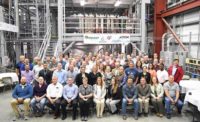Tunnel Collapse at Hanford Nuclear Waste Site Prompts Emergency Declaration
The collapse of a tunnel containing radioactive waste dealt another setback to the multibillion-dollar cleanup of the Hanford nuclear waste site in Washington state. There were no injuries in the collapse of a 20-ft by 20-ft section of a tunnel onto eight railcars carrying radioactive waste, and the Dept. of Energy says no radiation leaked from the PUREX site. But the site was put on lockdown during a sitewide emergency after the collapse was discovered May 9.
“The cave-in at the PUREX plant should remind everyone that the temporary solutions DOE has used for decades to contain radioactive waste at Hanford have limited life spans,” Sen. Ron Wyden (D-Ore.) said in a statement.
After being remotely analyzed for radiation and other concerns, crews filled in the tunnel with 54 truckloads of dirt.
The PUREX facility has been inactive since the 1980s, says Destry Henderson, spokesman for contractor CH2M Plateau Remediation, which is responsible for surveillance of the site and currently is tearing down the Plutonium Finishing Plant at Hanford. Henderson says officials are still evaluating options for how to decontaminate the rail cars and the rest of the PUREX complex.
The PUREX plant was constructed in the early 1950s and operated from 1956 to 1972 and again from 1983 to 1988. Several rail cars used to transport the irradiated fuel rods from the Hanford nuclear reactors to the processing canyons remain temporarily buried inside two tunnels near PUREX.
The cleanup effort falls into two main categories at Hanford: site cleanup and a vitrification plant to turn the radioactive liquid into glass for storage. But the process of building the vit plant, which broke ground in 2002 with technology never tried before, has hit snags that has moved its fully operational date from 2022 to 2039, while engineers still work on final design of the plant.
The original budget for just the vit plant has jumped from $4 billion to $16.8 billion. With uncertainty still hovering around the project, the U.S. Government Accountability Office recently suggested that Congress direct the Dept. of Energy to investigate the idea of switching from vitrified glass to encasing the waste in concrete.



